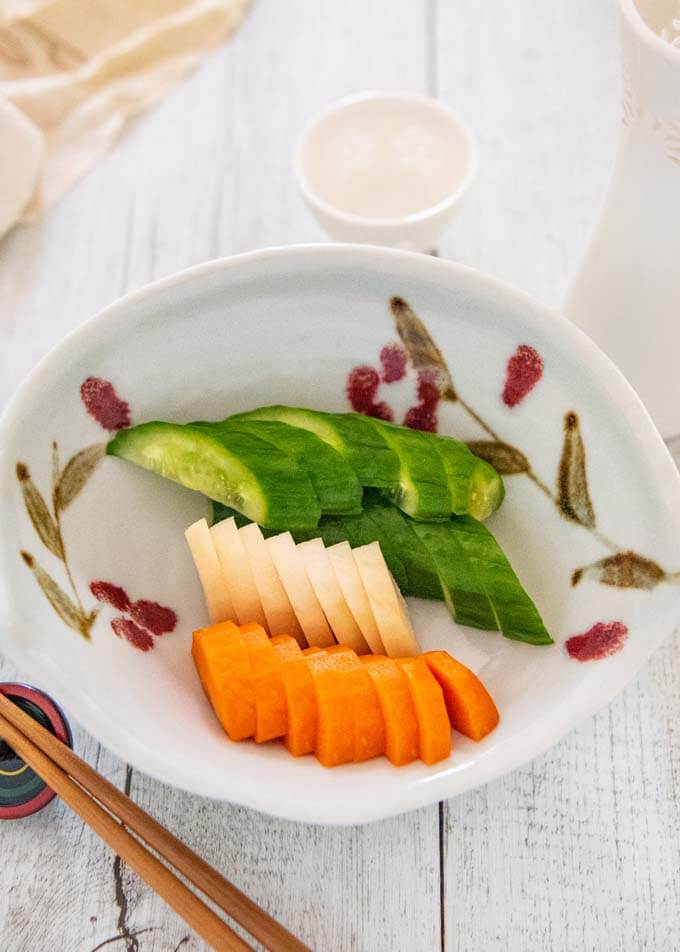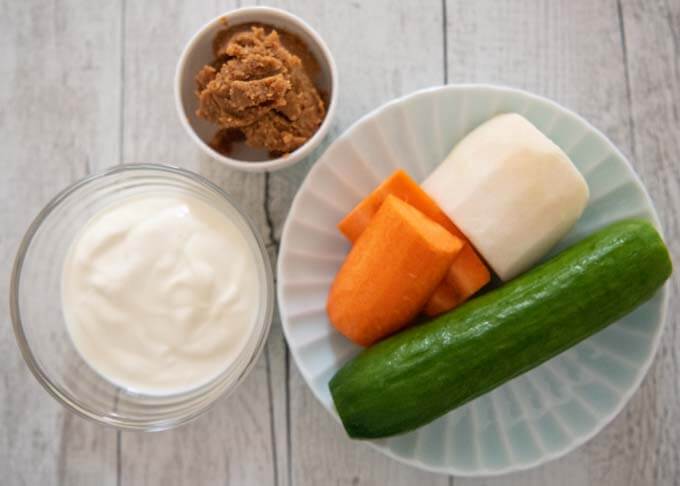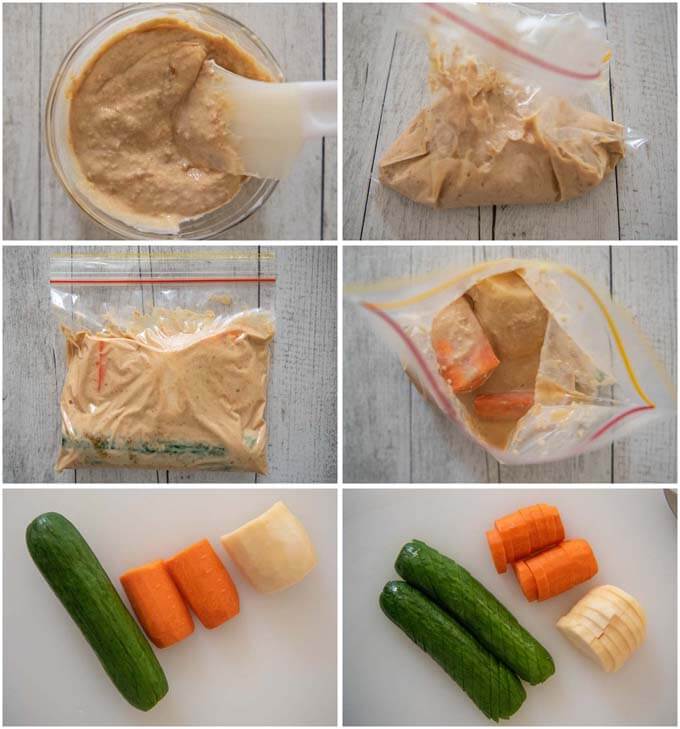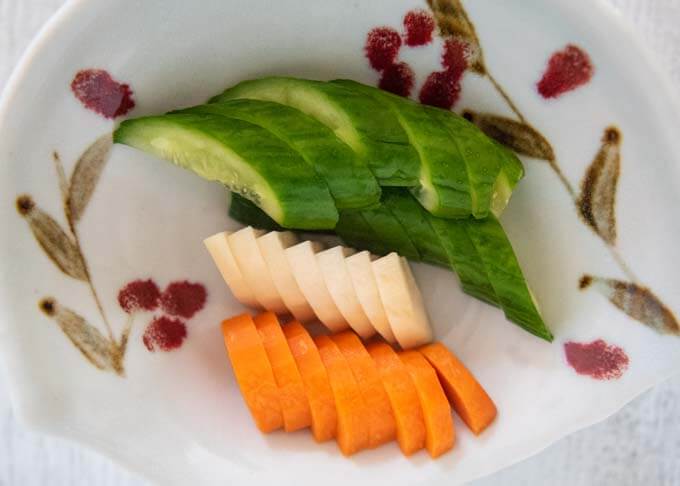My Miso Pickled Vegetables are slightly different from most Misozuke recipes you might know of. The traditional miso pickling base is made of miso with a small amount of mirin. But my marinade contains a substantial amount of yoghurt which gives a milder saltiness to the pickled vegetables.

As explained in my post Miso Marinated Pork, miso-based marinating/pickling is called ‘misozuke’ (味噌漬け). The marinade/pickling base is called ‘misodoko’ (味噌床), which came from the word ‘toko’ (床, bed) because you lay the ingredients to be marinated in the miso base.
I found that the traditional misodoko, which consists of almost just miso, makes the pickled vegetables quite salty. By mixing yoghurt, the amount of salt was reduced significantly and the pickled vegetables tasted just right for me.
My misodoko gives you a saltiness while keeping the flavour of the original vegetables.
What’s in My Miso Pickled Vegetables (Vegetable Misozuke)
The misodoko consists of just miso and yoghurt. I pickled three kinds of vegetables, but you can pickle almost anything.

- Miso, not sweet miso
- Greek yoghurt
- Cucumber, edges trimmed
- Carrot, halved vertically
- Daikon (white radish), halved vertically
I used brown miso, but you can use aka (red) miso or shiro (white) miso. In the case of shiro miso, use normal salty miso, not sweet miso such as Saikyo miso.
I used Greek yoghurt because it is less watery than natural yogurt. Since the miso is quite thick, you can use natural yoghurt if you prefer.
How to Make Miso Pickled Vegetables (Vegetable Misozuke)
It is super simple to make today’s pickles, just like many Japanese pickle recipes. You don’t cook anything on the cooktop, but it takes overnight to a full day to pickle.

- Mix miso and yoghurt well. This is the misodoko.
- Put the misodoko in a ziplock bag large enough to put all the vegetables in.
- Put the vegetables in the bag and pickle for at least 24 hours and up to 3 days in the fridge.
- Take the vegetables out of the bag and rinse the vegetables.
- Slice the vegetables into 5-7mm thick pieces to serve.
Depending on the vegetables, you need to adjust the size of the vegetable pieces. Cucumbers are quick to pickle, compared to daikon and carrot, so I pickled a whole cucumber. Carrot takes longer to pickle because there is less water in the flesh, so I halved it even if the thickness of the carrot is half the size of the daikon.
The vegetables that you usually cook before eating, such as pumpkin, burdock, and cauliflower can be blanched before pickling.
Other vegetables that you might try include cabbage leaves, ginger, celery, zucchini, turnip, etc.

The misodoko can be reused one more time within a few days. After the second pickling, misodoko becomes watery. Instead of vegetables, you can marinate sliced meat or fish for the second round, if you like.
The leftover misodoko can be used to make miso soup. Alternatively, adjust the saltiness of the misodoko by adding dashi stock, bring it to a boil, then use it as a dipping sauce for hot pot dish or noodles.
Yumiko![]()

My Miso Pickled Vegetables (Vegetable Misozuke) are slightly different from most Misozuke recipes you might know of. The traditional miso pickling base is made of miso with a small amount of mirin. But my marinade contains a substantial amount of yoghurt which gives a milder saltiness to the pickled vegetables.
I did not include Meal Ideas today because today's dish can go with almost anything as a side dish, or even nibbles.
- 1 cucumber (about 140g/4.9oz)
- 80g/2.8oz daikon (white radish)
- 70g/2.5oz carrot
- 3 tbsp miso (note 2)
- 4 tbsp Greek yoghurt (note 3)
-
Trim both ends of the cucumber.
-
Halve the daikon and carrot vertically to make half-cylindrical shapes.
-
Mix the Misodoko ingredients well in a bowl, until lump free.
-
Put the misodoko in a ziplock bag.
-
Put the vegetables in the bag and massage gently, ensuring that all the vegetable pieces are coated in the misodoko.
-
Remove the air inside the bag as much as possible, then seal it.
-
Leave the bag in the fridge for at least 24 hours, up to 3 days (note 5).
-
Remove the vegetables from the bag, scraping off the misodoko as much as possible.
-
Rinse off the miso around the vegetables, pat dry, then slice them into 5-7mm/3⁄16-¼" thick pieces.
1. The size/quantity of each vegetable can vary. As long as all the vegetables can be all coated in the misodoko, you can pickle any vegetables in different quantities.
If you are pickling vegetables that are usually cooked to eat, e.g., pumpkin, burdock, you should blanch them before pickling.
2. I used brown miso, but you can use aka (red) miso or shiro (white) miso. In the case of shiro miso, use normal salty miso, not sweet miso such as Saikyo miso.
3. I used Greek yoghurt because it is less watery than natural yoghurt. Since the miso is quite a thick paste, you can use natural yoghurt if you prefer.
4. The misodoko can be reused one more time within a few days. After the second pickling, misodoko becomes watery.
Instead of vegetables, you can marinate sliced meat or fish for the second round, if you like.
The leftover misodoko can be used to make miso soup. Alternatively, adjust the saltiness of the misodoko by adding dashi stock, bring it to a boil, then use it as a dipping sauce for hot pot dish or noodles.
5. The longer you pickle the vegetables, the saltier they become.
6. Nutrition per serving. It is assumed that 1/4 of the marinade is absorbed into the vegetables.
serving: 79g calories: 25kcal fat: 0.4g (0%) saturated fat: 0.1g (0%) trans fat: 0.0g polyunsaturated fat: 0.1g monounsaturated fat: 0.1g cholesterol: 0.2mg (0%) sodium: 138mg (6%) carbohydrates: 4.8g (2%) dietary fibre: 1.2g (4%) sugar: 2.4g protein: 1.1g vitamin D: 0% calcium: 25mg (2% iron: 0.3mg (2% potassium: 168mg (4%)
How long will these keep in the fridge?
Hi Heidi, it will keep 3-4 days in the fridge.
I have recently tried this recipe and it worked great for carrots and cucumbers. I have used what they call “white radish” in France and it looked like daikon, but maybe it’s a bit different vegetable and I wasn’t amazed how it turned out (too bitter), so I will skip it next time. But I will surely make it again with carrots and cucumbers, taste is amazing and so easy to make! I also appreciate other options listed and will try those too. Thank you for this recipe.
Hi Anita, great to hear. It’s so easy that you can keep Vegetable Misozuke in the fridge at all times!
I’ve eaten Japanese style most of my life and I’m interested in picking with miso. Like your recipes. Add me to your list to send out recipes and etc.
Hi Daniel, simply fill in your mail address on my site and click Subscribe. You will receive an email when I post a new recipe, usually weekly on Tuesday.
Thank you
Hi Yumiko
This looks really good, I’m excited to give it a try.
How long will the pickles keep for?
Would kale be a suitable vegetable and would it need blanching first?
Thank you
Hi Alison, the pickled vegetables keeps for a few days in the fridge. I have pickled cabbage before, but not kale. If you would like to try it, I’d suggest that you sprinkle salt over the leaves, let them soften and squeeze the water out before pickling them. Please let me know how it went.